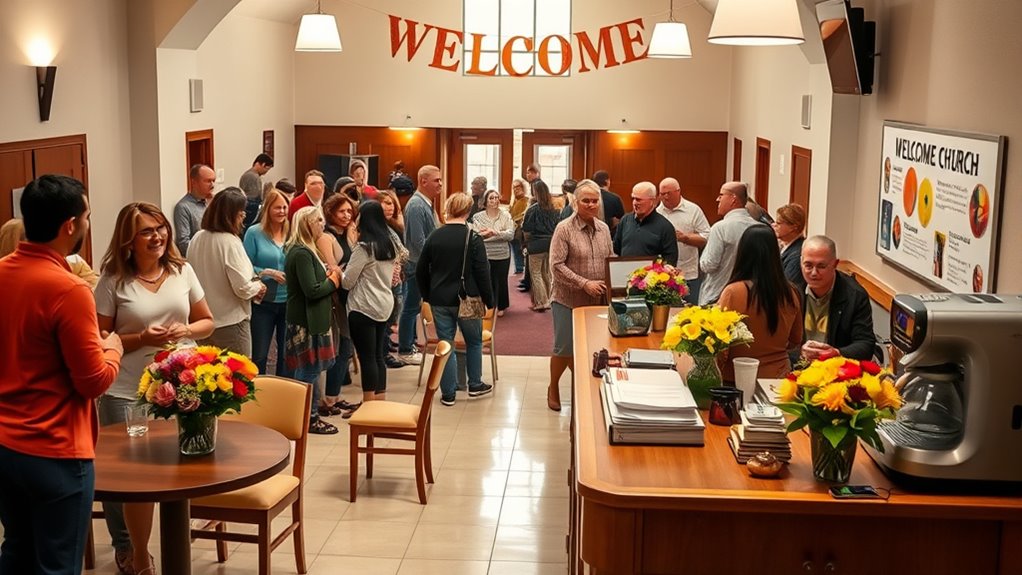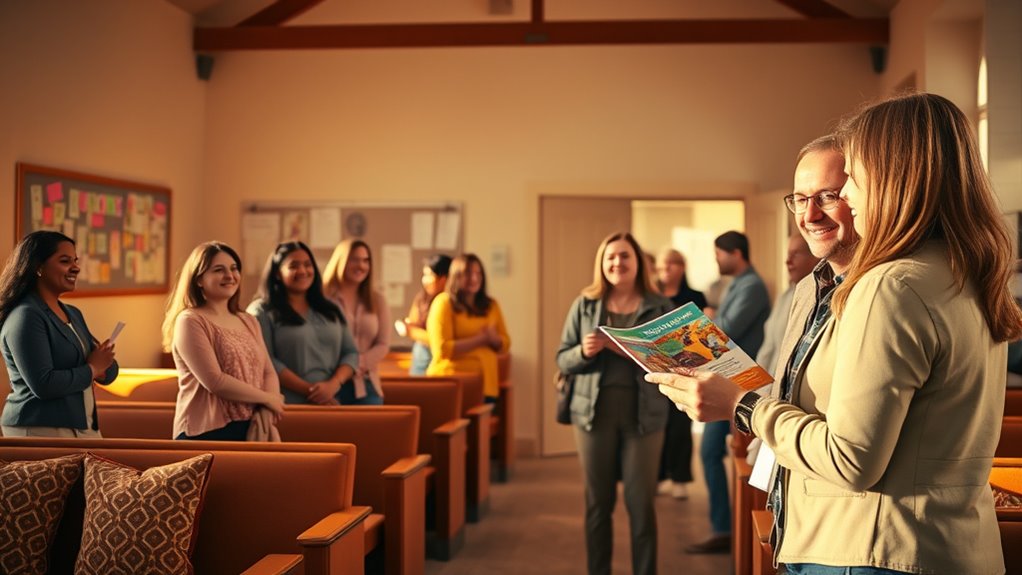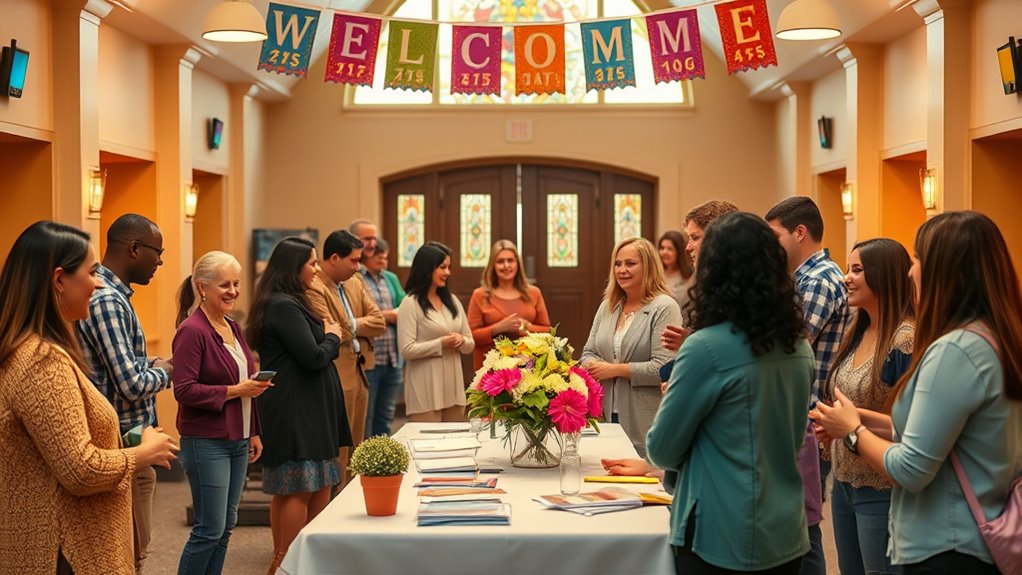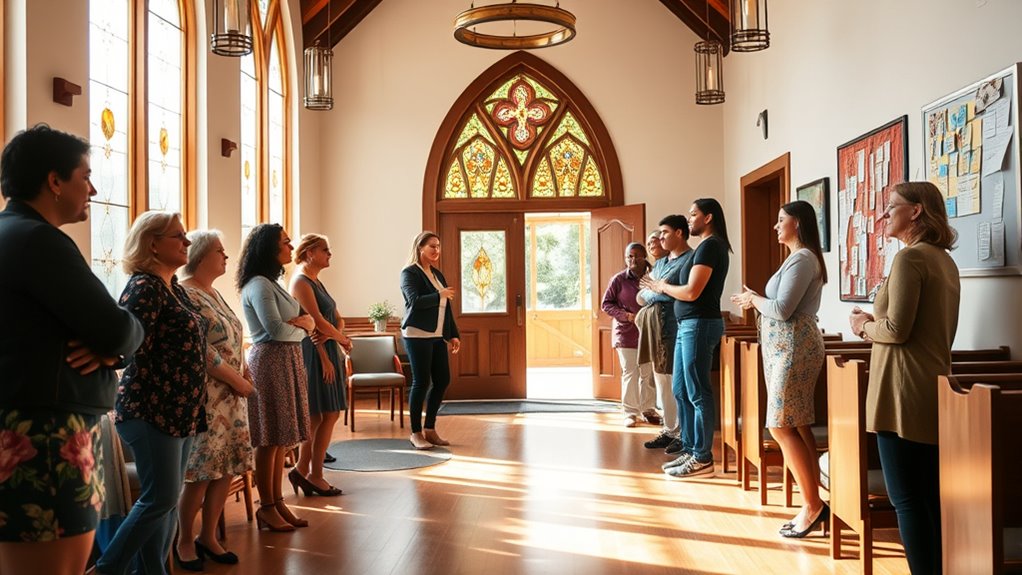To create a welcoming church environment for newcomers, focus on evaluating your current hospitality practices and making intentional improvements. Greet visitors warmly, use clear signage, and guarantee your space is accessible and inviting. Train your team to form genuine connections, practice cultural sensitivity, and follow up with newcomers. Plan inclusive community activities that foster relationship-building. Continuously gather feedback and adapt your approach to enhance everyone’s experience—keep exploring ways to strengthen your welcoming environment.
Key Takeaways
- Train staff and volunteers in friendly greetings, active listening, cultural sensitivity, and conflict resolution to foster genuine connections.
- Use clear signage, accessible pathways, warm decor, and multilingual elements to create an inviting and inclusive physical environment.
- Incorporate personalized communication, follow-up, and thoughtful gestures to make newcomers feel valued and build trust.
- Plan community activities that encourage interaction, relationship-building, and demonstrate ongoing commitment.
- Regularly gather feedback, analyze themes, and adapt practices to continually improve inclusivity and hospitality efforts.
Assessing Your Current Hospitality Practices

To create a welcoming environment for newcomers, you first need to understand how your church currently greets and engages visitors. Start by evaluating your volunteer recruitment efforts—are your volunteers friendly, attentive, and well-trained? Consider how they interact with newcomers and whether they’re actively creating a positive first impression. Also, assess your facility maintenance; a clean, well-organized space signals care and respect for guests. Are signs clear and visible? Is the entryway inviting? Identifying gaps in these areas helps you pinpoint strengths and weaknesses. Gathering feedback from recent visitors and volunteers can reveal how your current hospitality practices resonate. Incorporating self watering plant pots as an analogy can remind you to nurture and maintain your welcoming environment consistently. This honest assessment forms the foundation for making meaningful improvements that foster a more welcoming environment.
Designing a Friendly and Accessible Entryway

After evaluating your current hospitality practices, the next step is to focus on how your entryway sets the tone for visitors. Make sure your entryway features welcoming gestures, like friendly greetings from staff or volunteers, to create an inviting atmosphere right away. Use friendly signage that clearly indicates entrances and provides helpful information without feeling overwhelming. Keep pathways unobstructed and well-lit to assure accessibility for everyone, including those with mobility challenges. Consider adding comfortable seating nearby to encourage visitors to feel at ease. Small touches, such as bright colors or warm decorations, can also make a big difference. Your goal is to create an environment that feels open, friendly, and accessible from the moment newcomers arrive. Incorporating insights from the history of pinball machines, such as the importance of engaging design, can inspire creative ways to make your entryway more appealing.
Training Your Team to Embrace Visitors

Training your team to embrace visitors starts with developing strong hospitality skills that make newcomers feel comfortable. Encourage your team to focus on genuine connections rather than just routine greetings. When your team shows authentic care, visitors sense it and are more likely to return. Incorporating positive guest experiences can significantly enhance how visitors perceive their initial interactions.
Cultivating Hospitality Skills
Building strong hospitality skills begins with equipping your team to genuinely connect with visitors. Focus on developing cultural sensitivity so team members can recognize and respect diverse backgrounds, making newcomers feel valued. Encourage active listening to understand visitors’ needs and concerns. Conflict resolution training is essential, helping your team handle awkward situations or misunderstandings calmly and effectively. Role-playing scenarios can boost confidence in addressing challenging interactions. Emphasize the importance of warmth, openness, and attentiveness in every encounter. Recognizing the importance of projector image quality can also enhance the visual experience during gatherings, making the environment more engaging and welcoming. By honing these skills, your team will become more confident in creating an inviting atmosphere. When visitors experience genuine kindness and respect, they’re more likely to feel at home and want to return. Cultivating these hospitality skills transforms your church into a truly welcoming community.
Emphasizing Genuine Connection
To truly embrace visitors, your team must go beyond polite greetings and focus on forming genuine connections. A hospitality mindset involves authentic warmth and intentional welcoming gestures that show you care. Encourage your team to ask open-ended questions and listen actively, making visitors feel heard and valued. Small actions like eye contact, a genuine smile, or a personalized welcome can make a big difference. Remember, connection isn’t just about words but about creating a comfortable atmosphere. Use this table to guide your team:
| Action | Example | Impact |
|---|---|---|
| Warm greeting | “Glad you’re here today!” | Sets a friendly tone |
| Personal touch | Remembering visitor names | Builds trust |
| Active listening | Asking follow-up questions | Shows genuine interest |
| Welcoming gestures | Offering a program or coffee | Creates a sense of belonging |
Additionally, training your team to recognize market trends in visitor behavior can help tailor the welcoming experience to meet evolving expectations.
Creating Clear Signage and Information Resources

Clear signage and well-organized information resources are essential for helping newcomers feel comfortable and find their way around your church. Use multilingual signage to accommodate diverse backgrounds, ensuring everyone understands directions and key areas. Clear, simple language helps avoid confusion, especially for those unfamiliar with church layouts. Incorporate accessible design by including large fonts, high-contrast colors, and tactile elements for visitors with visual impairments. Place signs at eye level and in strategic locations—near entrances, restrooms, and main gathering spaces—to guide newcomers effortlessly. Provide printed brochures or digital resources that explain church programs, service times, and amenities. Well-thought-out signage and info resources show you value inclusivity, making visitors feel confident and welcome as they engage with your church community.
Developing Personal Connections and Follow-up Strategies

Building personal connections starts with genuine outreach—greet newcomers warmly and show interest in their stories. To stay connected, use effective follow-up methods like personalized messages or invites to upcoming events. These strategies help newcomers feel valued and encourage ongoing engagement with your church community. Incorporating personalized communication can further strengthen these relationships.
Personal Outreach Techniques
Establishing genuine personal connections is essential for making newcomers feel truly welcomed. You can do this through targeted evangelism outreach, where you personally invite new attendees or invite them to participate in activities that foster relationship-building. Social media engagement also plays a crucial role; by connecting with newcomers online, you show genuine interest and create opportunities for conversation outside of church services. When you meet someone new, ask open-ended questions to learn about their interests and spiritual journey, making the interaction meaningful. Remember, authentic engagement builds trust and encourages ongoing participation. Personal outreach isn’t just about initial contact—it’s about demonstrating that they matter to your church community, helping them feel valued and enthusiastic to deepen their involvement. Incorporating elements of spiritual energy awareness during interactions can also help foster a deeper sense of connection and comfort.
Effective Follow-up Methods
Effective follow-up is essential for transforming initial connections into lasting relationships. Adopting a hospitality mindset helps you genuinely care about newcomers, making them feel valued beyond their first visit. Use welcoming gestures like personalized messages, thank-you notes, or invitations to upcoming events. These small acts show you’re attentive and committed to building a relationship. When you follow up promptly, it reinforces their positive experience and encourages ongoing engagement. Remember, sincere interest and friendly communication foster trust and comfort. By consistently demonstrating warmth and care, you create a safe space where newcomers feel they belong. Incorporating Gold IRA rollovers into your financial planning can also provide stability, giving your congregation members confidence in their long-term security. Strong follow-up strategies turn a brief visit into a meaningful relationship, helping newcomers see your church as a welcoming, inclusive community they want to be part of long-term.
Incorporating Inclusive Language and Practices

Incorporating inclusive language and practices is essential for creating a welcoming environment where all newcomers feel valued and respected. By practicing language sensitivity and cultural awareness, you guarantee your words and actions reflect respect for diverse backgrounds. Use gender-neutral terms, avoid assumptions, and listen actively to understand individual preferences. This approach helps break down barriers and fosters trust. To illustrate, consider the following:
| Respecting Identity | Cultural Awareness | Open Communication |
|---|---|---|
| Use preferred pronouns | Learn cultural customs | Encourage honest feedback |
| Avoid stereotypes | Celebrate diversity | Ask questions, listen actively |
| Be mindful of language | Respect traditions | Foster understanding |
These practices create a foundation where everyone feels seen and appreciated. Additionally, implementing mindful communication strategies ensures ongoing respect and understanding within the community.
Planning Community-Building Activities for Newcomers

Planning community-building activities is an essential step in helping newcomers feel connected and engaged. When you organize events that encourage interaction, you foster a sense of belonging and trust. Focus on activities that promote community engagement, like small group dinners, service projects, or interest-based meetups. Effective event planning involves understanding your newcomers’ preferences and creating inclusive, welcoming environments. Keep activities diverse and accessible to ensure everyone feels comfortable participating. Remember, the goal is to build relationships, so choose formats that facilitate conversation and connection. Well-planned events not only introduce newcomers to your church community but also demonstrate your commitment to their integration. By thoughtfully organizing these activities, you lay the foundation for lasting involvement and spiritual growth. Data privacy challenges highlight the importance of safeguarding personal information during community events, ensuring trust and confidentiality are maintained.
Continually Improving Through Feedback and Reflection

To guarantee your efforts in creating a welcoming church environment continually improve, regularly gathering feedback and engaging in reflection is essential. Listening to newcomers’ experiences helps you identify areas for growth, especially in fostering cultural sensitivity and supporting spiritual growth. Encourage honest feedback through surveys or conversations, and analyze this input with an open mind. Reflect on your strategies and be willing to adapt. Use the table below to track feedback themes and action items:
| Feedback Theme | Action Steps |
|---|---|
| Cultural sensitivity | Provide diversity training |
| Communication clarity | Simplify messaging |
| Accessibility improvements | Enhance physical and program access |
| Engagement opportunities | Increase small group activities |
| Spiritual growth support | Offer tailored spiritual resources |
This ongoing process keeps your church environment welcoming and responsive.
Frequently Asked Questions
How Can We Evaluate the Effectiveness of Our Hospitality Efforts?
To evaluate your hospitality efforts, you should use feedback mechanisms like surveys and informal conversations to gather honest input from newcomers. Track success metrics such as attendance rates, repeat visits, and participation in activities. By regularly analyzing this data, you can identify areas for improvement and see what’s working. Engaging with your congregation and adjusting based on their feedback helps guarantee your hospitality efforts effectively create a welcoming environment.
What Are Common Challenges in Creating an Inclusive Environment?
You might face challenges like cultural insensitivity or unintentional exclusion, making newcomers feel unwelcome. To overcome these, guarantee your team practices cultural sensitivity and offers genuine welcoming gestures, like personalized greetings or language support. Be mindful of diverse backgrounds and avoid assumptions. Regular training and open communication help create a truly inclusive environment, where everyone feels valued and comfortable from their first visit onward.
How Do We Handle Cultural Differences Among Diverse Visitors?
Imagine a visitor from another country struggles with language barriers and cultural differences. You show cultural sensitivity by learning basic greetings and customs, making them feel respected. You can also provide translated materials or interpreters. By actively addressing language barriers and understanding diverse traditions, you create a more inclusive environment. This approach encourages newcomers to feel welcomed, valued, and enthusiastic to participate, enriching your church community.
What Resources Are Best for Ongoing Staff Training?
You should prioritize training programs that focus on cultural competence and effective communication, ensuring your staff stays informed and skilled. Incorporate mentorship initiatives where experienced team members guide newcomers and new staff alike, fostering continuous learning. Regular workshops, online courses, and peer coaching can keep your team engaged and prepared. These resources help your staff grow, stay motivated, and create a more welcoming environment for everyone.
How Can Technology Enhance Newcomer Engagement?
Technology transforms your newcomer experience by making it more manageable and memorable. You can facilitate friendly, fast, and frictionless engagement with virtual tours that introduce your church’s space, and mobile check-in systems that streamline arrivals. These tech tools create a seamless, stress-free start, encouraging newcomers to feel welcomed, connected, and comfortable. By blending digital convenience with personal warmth, you foster a friendly environment that invites newcomers to stay and succeed.
Conclusion
Creating a welcoming church environment is like tending a garden—you need to nurture it consistently. By evaluating your practices, training your team, and building genuine connections, you’ll cultivate a space where newcomers feel truly at home. Keep listening and adapting, because hospitality isn’t a one-time act but an ongoing journey. When you open your heart, you open the door for others to find belonging and grow alongside you.










